ABSTRACT
In this region forest area occur from the plain zone Quercetum, Alnusetum, Aceretum, Fagetum, Fageto-Carpinetum, Parrotietum, Querceto-Fagetum, Fageto-Quercetum, Carpineto-Fagetum, up to 1400 m, the xerophyte plants are dominant in region with frigana, pseudomaquis, steppe, rocky-stony and pebbly ecosystems between 1400 and 2582 m. The forest area are widespread in the low altitude of region and among the forest, at the high altitudes, there are some formations. These are Dianthusetum, Sedetum, Campanuletum, Spergularietum, Nepetetum, Prangosetum, Silenetum, Asperulifolietum, Iridetum, Ziziphoretum, Thymetum, Onobrychisetum, Acantholimonetum, Festuceto-Astragaletum, Pyreteto-Festucetum, Astragaleto-Acantholimonetum, Festuceto-Astragaletum, Thymeto-Astragaleto-Acantholimonetum, Ilexetum, Paeonieto-Ilexetum, Fageto-Ilexetum. There are some morphological are some changes on the stem and leaves become small, the presence of rosette, on the upper of ground the plant become cosh and ball, the presence of underground, adaptation on the xerophyte plants of high mountainous zone. The members of Liliaceae, Iridaceae, Orchidaceae, families can be given for this category. Among these, species belong to Iris, species belong to Allium, species belong to Gagea and 4 species belong to Muscari genus. These geophytes species are important for the flora of autumn and spring and they have temporary aspect for the vegetation of region. These icing of plants are characterized for mountainous ecosystem and can survive on the stony-pebbly and on the peak humus soils. In this region the plants are categorized according to their root system and 41.6% stoke root, 0.2% fringe-stake root, .8% fringe were determined. Bulbous, tuberous and rizomic plants have an important role on the mountainous ecosystem of phytosenolocical structure as a seasonally.
PDF Abstract XML References Citation
How to cite this article
DOI: 10.3923/ajps.2006.899.904
URL: https://scialert.net/abstract/?doi=ajps.2006.899.904
INTRODUCTION
The Talysh is one of the South East of Azerbaijan. Talysh region is one of the richest regions from the point of flora and vegetation in Azerbaijan. Seven hundred and nine species from 76 families and 329 genus are seen here (Haciyev et al., 1979). Flora of Talysh shows nearness to different mountainous regions of Caucasian. This shows again the general similarity of their stage and shows its connection with flora of Tetis. It shows difference with areal groups of the Mediterranean and Middle-Asia. These groups include species of Fabaceae families which love drought. Widespread species seen here are especially Astragalus, Onobrychis and Medicago. With this characteristic, Talysh region is similar to the Mediterranean flora. Protection of biological diversity of biosphere in this region is one of the important problems. Among these adaptations there 517 species very determined. Among these, 26% are hairy herbs, 11.4% bulbous, 13.3% with acicular leaves, 10.1% tuklu, with resin and oil plants, 9.55% with broad unhairy leaves, 7.9% with succulent plants, 4.8% with thorny-coshing plants, 2.3% with thorny shrub and 0.4% with needled-leaves shrubs.
The members of Liliaceae, Iridaceae, Orchidaceae, families can be given for this category. Among these, 6 species belong to Iris, 5 species belong to Allium, 4 species belong to Gagea and 4 species belong to Muscari genus. These geophytes species are important for the flora of autumn and spring and they have temporary aspect for the vegetation of region.
MATERIALS AND METHODS
Materials of this study are mode up of materials which were collected from investigation of high mountain regions of Talysh in 1997-2001. It was terrified from “Land geobotanic” (Polevaya Geobotanica, 1959-1976) in land geobotanic investigations and benefited from “Flora Azerbaydjana” in determining plants (Flora Azerbaydjana, 1950-1961). In naming formations, dominant principles have been used.
RESULTS AND DISCUSSION
As seen from plant cover of Talysh, as well as forest, steppe, frigana, wild grass, subalpine, which form zone here, plant types, water-swamp, rocky types are also characteristic (Fig. 1, Table 1). In this region distribution of vegetation types according to vertical zone is different from other regions of Azerbaijan (Fig. 2).
Nepeta transcaucasica, Onobrychis transcaucasica, Zerna variegata, Medicago caucasica, Ranunculus elegans, Symphytum asperum, S. caucasicum, Lotus caucasicus are widerspread and characteristic in Talysh region but Allium lenkoranica, A. talyschence, Astragalus gudrati, A. kosmoljanicus, Scutellaria prilipkoana, Pimpinella grossheimii, Scrophularia hyrcana are spreaded in a narrower areal and they are endemic species. Part of these endemics come into existence at the end of 3rd glacier period and at the beginning of species which has come from very old periods because this region hasn’t been exposed to effect of getting icy in glacial period. Mountainous forests are widespread in Talysh's relict formations of down, middle and upper mountainous zones (Fig. 1). Albizzia julibrissin, Ficus carica, F. hyrcana, Punica granatum, Paliurus spina-christi, Gleditschia caspica, Parrotia persica, Danae ramasisima, Quercus castaneifolia, Rhamnus grandiflora, Pyrus boissieriana, Alnus subcordata, Acer velitinum, A. luteum, A. hyrcanum, Fagus orientalis, Zelkova carpinifolia Prunus spinosa, P. mahaleb, Pyrus communis, Convallaria transcaucasica, Nelumbium caspicum, Paeonia mlokosowitschii, Adonis wolgensis can be shown as widespread relict species in these forests.
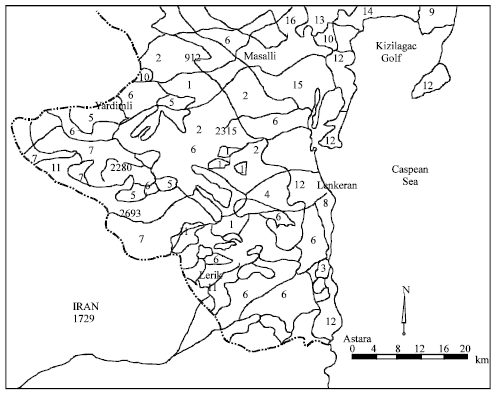 | |
| Fig. 1: | Vegetation map of Talysh region in Azerbaijan 1. Mountain forests (Quercus macranthera, Carpinus caucasicus, Fagus orientalis), 2. Relict Hyrkanus forests (Quercetum, Fagetum, Carpinetum, Parrotietum, Alnusetum, Pterocarietum, Ilexetum, Taxucetum), 3. Orderlines forests (Quercus castaneifolia, Q. Longipes), 4. Low mountainous forests (Quercus longipes, Alnus subcordata, Pterocaria pterocarpa), 5. Pseudomaki (Ilexetum), 6. Wild grass around forest, 7. Mountain-Xerophyte vegetation, 8. Tugaj forests (Populus hibridus, Acer velitinium, Ulmus elliptica, Alnus barbata, Salixetum, Tamarixetum), 9. Juncusetum, 10. Wild grass-shrub (Alhagi pseudoalhagi, Cunodon dactylon, Glysirriza glabra), 11. Steppe (Astragaleto-Poaetum), 12. Shora of sea, sandy deserts (Artemisia arenaria), 13. Deserts with formations of Salsoleto-Artemisietum (Artemisia fragrans +Salsola dendroides) and Salsoletum ( Salsola dendroides, S. ericoides)), 14. Dasert with formations of Kalidietum, Anabazisetum, Halostachysetum and Suaedetum, 15. Culture field of Artemisetum and Artemiseto-Phryganetum, 16. With superiority of Poa bulbosa and Eremopyrum orientalis efemerosez semi-deserts |
| Table 1: | Vegetation types and dominant formations and species of Talysh Regions |
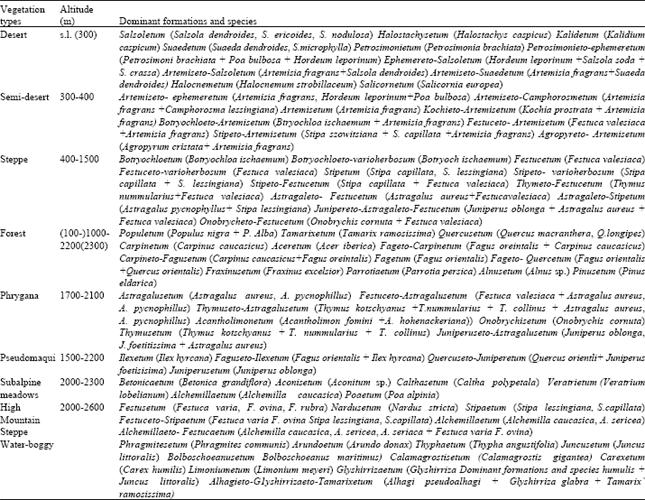 | |
Plant cover of Talysh which has subtropic climate conditions and is a mountainous region is various. In plans and shore of the Caspian Sea’s sandy lands formations with increase of tree species and with domination of species like Artemisia arenaria, (A. sowitsiana), Phragmites communis, Juncus littoralis, Bolboschianus marittimus, Thypha angustifolia, Carex remota form various forest formations. In characteristic forest formations of plain regions, Parrotia persica Quercus castaneifolia, Carpinus caucasica, Zelkova carpinifolia, in marshed forest type formation Alnus barbata, Carex remota, Cardamine tenera, Lucopus europaeus and in plain forests also Acer velitinum, Ficus carica, Punica granatum, Buxus sempervirens, Ruscus hurcana, Crataegus monoguna, herb plants Rumex pulcher, Sambucus nigra, Poa nemoralis, Primula heterochroma, Viola occulta, Solanum persicum, Carex contigua, Allium erubescens, Sedum oppostrifolium, Crocus speciosus and likes are found. Here, Parrotia persica species are not found, instead of it Fagus orientalis forms more intense monodominant and polidominant formations of Fagetum, Fageto-Quercusetum and Quercuseto-Fagetum. In these formations, length of orientalis is 20-30 m and number of trees is more infrequent in down mountainous forest zones. Fagus orientalis forms 32% of Azerbaijan’s forest regions (Safarov and Olisayev, 1991). Trunks of bigger trees facing north side are wrapped by Hedera pastuchovi. Ilex hyrcana, Danae ramosissima, Mespulus germanica, Crataegus orientalis, Carpinus orientalis, C. macrocarpa, Sorbus terminalis, Prunus divaricata, Cydonia oblonga, Pyrus boisseri, Rosa tomentosa, Rubus ibericus are widespread in subforest layer which forms the second layer here.
Near Siov village, Taxus baccata which has length of 1-10 m forms monodominant formation (Taxetum). As well as Taxus baccatan, Lonicera iberica and Carpinus schuschaensis like species are found.
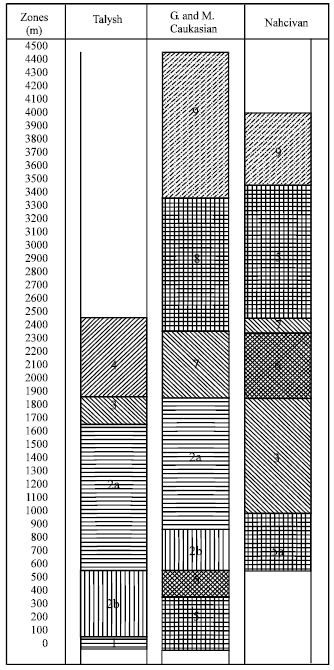 | |
| Fig. 2: | Distribution of vegetation types of Azerbaijan according to vertical zones 1: Ordirlines forests, 2: Mountainous wide leave forests, 2a: Mixed Hyrcana originated relict forest, 2b: Quercusetum, Quercuseto-Carpinetum, Fagetum, Fageto-Carpineto-Quercusetum, 3: Mountain Xeropyte and mountain foot steppe, 4: High mountain wild grass steppe and steppe, 5: Semi desert and desert, 5a: Semi steppe and arid infrequent forest, 6: Phrygana and mountain steppes, 7: Subalpine wild grass steppe, 8: Alpine wild grass, 9: Subnival and naval |
This formation has been recorded as characteristic by Grossheym (1926). In high mountainous zone forests; Quercus macranthera, Carpinus orientalis, C. macrocarpa, C. caucasica, Acer laetum, A. velitinum, A. campestre, Quercus castaneifolia, Fraxinus excelcior, Ilex hyrcana, Mespilus germanica, Crataegus orientalis, C. kyrtostyla, C. lagenaria, Eonymus latifolius, Pyrus hurcana, Lonicera iberica and herb trunk plants of; Poa nemoralis, Asperula odorata, Dryopteris filix-mass, Dactylis glomerata, Poa pratensis, Brachypodium silvaticum, Campanula ranunculoides, Agrostis tenuis, Digitalis nervosa, Geum urbanum, Fragaria vesca, Vicia cracea, Stachys balansae, Carex tomentosa, Primula macrocalyx, Stellaria media, Trifolium pratense, Bromus squarrosa, Silene ruprechtii, Asplenium septentrionale are found but in north faced side of high mountain zones, Fagus orientalis is found only. Quercus castaneifolia and Carpinus caucasica species are sometimes found and they are very infrequent but Quercus macranthera is abundant and found more densely. With respect to middle mountain zone forests, in evergreen shrub layer of high mountain forests, Ilex hyrcana is widespread and sometimes it forms shrubs of 10 m2 dimension. Where the forests end, shrubs and herbs acquire priority in rockery places. At the height of 1600-1800 m, in south and south-east sides, firigana typed vegetations of Astragaletum, Onobrychisetum and Acantholimonetum formations are found. These formations are shown to be exist (Grossheym, 1948; Yurtsev, 1981) from 3rd period Prilipko (1939, 1954) and Zoharu (1973) shows 16 formations in Nahcivan’s firigana vegetation. Most of them are found in mountainous regions of Talysh. Some of them can be shown as Astragalus aureusetum, Acantholimon hohenacerietum, Achillea vermicularetum, Euphorbia szovitsietum, E. marschallianaetum, Thymus trautvetterietum. In high mountainous regions of Talysh, geophytes are rich and Allium (18 species), Ornithogalum, Merendera, Muscari, Gagea, Crocus, Orchis, Colchicum, Puschkinia and species include in genus form seasonal aspect. Altitude from 1400-1600 metres to 2500 (2600) metres from steppe and high mountain steppe of zone vegetation type (Haciyev, 1996). In steppe formations formed by dominance and edification of Festuca valesiaca, Stipa capillata, Astragalus aureus, A. pycnophyllus, Thymus trautvetteri, Achillea setacea, Artemisia fragrans, Koeleria caucasica, Carex humilis and Phleum phleoides are added to phytosenoze composition as co-dominant. In north and north sides of 2200-2800 m, as local, monodominant and polydominant formations formed by Betonicetum, Alchemilletum, Agrostisetum, Rumexetum, Cephalariaetum, Heraciumetum, Trifolietum, Poaetum, Dactylisetum and high mountain wild grass vegetation are found.
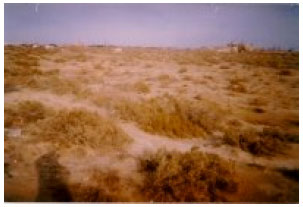 | |
| Fig. 3: | Salsoleto-Artemisetum |
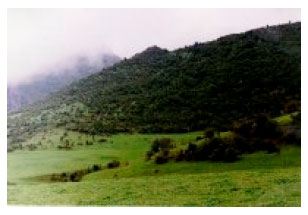 | |
| Fig. 4: | Low mountainous forests |
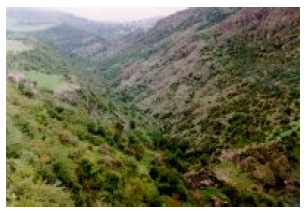 | |
| Fig. 5: | Ilexetum |
Formation which formed with domination of Heracleum trachyloma existed in the beginning of 3rd period (Haciyev et al., 1979; Prilipko, 1939). According to Haciyev et al. (1979), Nelimbium caspicumetum which belongs to relict asosiation hascome from the 3rd perioduntil nowadays (Atamov, 2003). This association is widespread in Talysh’s plain marsh fields. Plants like Potomageton pectinoides, P. lucens, Myriophyllum spicatum, Trapa hyrcana, Ceratophyllum demersum are widespread and they form micro groups as spats.
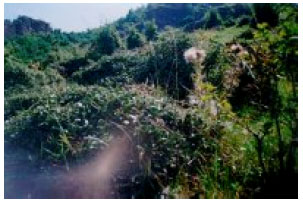 | |
| Fig. 6: | Ilex hyrcana |
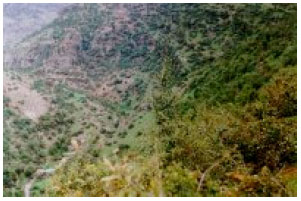 | |
| Fig. 7: | Pseudomaki |
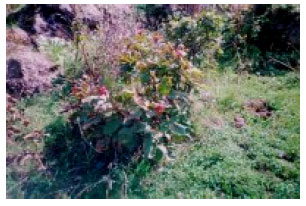 | |
| Fig. 8: | Paeonia mlokosowitschi |
In Taliş marsh regions, Iris pseudocorus, Sparganium erectum, Schoenoplectus lacutris and Heleocharis eupalustris constitute formations. In Taliş Creek sides, Pterocarya pterocarpa and Alnus subcordata constitute monodominant and polydominant formations in wide areas. Alnus barbata species is characteristic for marshes forests of Talysh. Ficus hyrcana which is an endemic species for down and middle mountainous forests of Talis Himilus lupulus, Smilax exelsa, Sambucus ebulus, Carex grioletii, Cardamine parviflora, Poa palustris, in marshes Juncus grex sp. And also various formations (Juncusetum, Ficusetum, Sanbucusetum, Carexcetum, Poaetum) are found. Especially in Alnusetum formations, plants like Hedera helix and Tamus communis which are winder are more widespread. In addition to Talysh, in south sides of mountain of Big Caucasian in Azerbaijan, relict hurcana trees of Parrotia persica, Quercus castaneifolia, Carpinus caucasicus, Zelkova carpinifolia, Z. hyrcana, Ulmus elliptica, Prunus caspica, Populus hyrcana, are found (Haciyev et al., 1990; Zoharu, 1973). In down level of these forests, evergreen shrub species of Ruscus hyrcana, Donae rasemosa are widespread. Gleditschia caspica forms formations in side of Talysh’s mountain fields and is widespread. In Sea located slopes of this formation, Albizzia julibrissin, Tilia platyphyllos, T. prilipkoana form mixed forest formations.
In higher regions, Acer velutinum, Fagus orientalis, Taxus baccata, Buxus hyrcana are more widespread and form various formations.
In the Thalysh’s regions; desert, semi-desert, steppe, forest, phyrigana, subalpine meadow formations are zonal concentrated, in interzonal vegetation formations like are more characteristic and more concentrated (Atamov and Haciyev, 2001).
Existence of relict formation of Talysh depends on not been exposed to glaciations of this region. Quercetum (Quercus castaneifolia), Parrotietum (Parrotia persica), Facetum (Fagus orientalis), Ficusetum (Ficus hyrcana), Paeoniaetum (Paeonia mlokosowitschii), Zelkovetum (Zelkova carpinifolia), Rhamnusetum (Rhamnus grandiflora), Ilexetum (Ilex hyrcana), Donaetum (Donae rasemosa), Ruscusetum (Ruscus hurcanus), Gleditschietum (Gleditschia caspica), Trapetum (Trapa hyrcana), Buxucetum (Buxus hurcana) can be shown as the exist relict formation in Talysh region (Grossheym, 1926; Zoharu, 1973; Safarov and Olisayev, 1991; Atamov and Haciyev, 2001; Atamov, 2003). Fields covered by blockhouse of Hyrcanus which related to protection of these formations must be widened. In this region, in high mountain parts, protection of widespread firigana (Astragaletum, Acantholimonetum, Onobrychetum), pseudomaki (Ilexetum), mountain steppe (Festucetum, Astragaleto-Festucetum, Thymeto-Festucetum), endemic, relict and rare species of wild grass typed vegetations of subalpine zones, their formations and associations must be provided (Fig. 3-8, Table 1).








